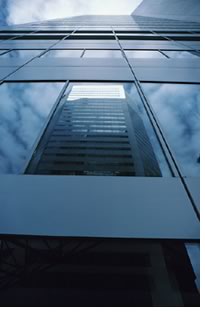

05/2005

by James B. Atkins, FAIA, and Grant A. Simpson, FAIA
Once there was an illustrated joke where an Egyptian architect was gleefully announcing to his workers that the firm had been awarded the Pharaoh’s pyramid contract. The architect was a high ranking official in his time, and it is well known that high ranking officials who worked on the pyramids were ultimately sealed in the tomb along with their leader. Although the joke was funny, the thought of an architect entering into a fatalistic contract hits just a little too close to home these days.
Today, we need not worry about losing our life for doing a project, but we should be concerned about losing our livelihood. As we compete for commissions, we may be inclined to embellish our representations in order to present ourselves in the best light. These actions are not intended to mislead, but if we tell our clients that we are the best around, they may expect our work to be better than everyone else’s. This expectation exceeds the definition of the standard of care and could come back to haunt us in the event of a claim.
 This article will explore the risks associated with marketing and how
we unwittingly create expectations that can rise above our capabilities
and the prevailing standard of practice. For a general perspective, we
will look at AIA Document B431, Architect’s Qualification Statement,
and the guidance that it gives us in accurately presenting our skills
and experiences. The aspects of assembling a project team with other
design professionals will be reviewed along with the dangers of “borrowing” the
experiences of others to beef up our credentials. Finally, we will examine
some aspects of state licensing laws and how they impose limitations
on how we can legally represent ourselves in our practice.
This article will explore the risks associated with marketing and how
we unwittingly create expectations that can rise above our capabilities
and the prevailing standard of practice. For a general perspective, we
will look at AIA Document B431, Architect’s Qualification Statement,
and the guidance that it gives us in accurately presenting our skills
and experiences. The aspects of assembling a project team with other
design professionals will be reviewed along with the dangers of “borrowing” the
experiences of others to beef up our credentials. Finally, we will examine
some aspects of state licensing laws and how they impose limitations
on how we can legally represent ourselves in our practice.
AIA Document B431-1993, Architect’s
Qualification Statement
In Article 2, “General Statement of Qualifications,” the
user is asked to describe the firm’s particular qualifications
to perform the work on a proposed project. Naturally, we are inclined
to present unique qualifications to the greatest extent possible so as
to set ourselves apart from the competition. However, the warning is
given in the instructions under Section A, General Information, Paragraph
3, Code of Ethics, “All information contained in or attached to
the form should be accurate and should not be edited to present a misleading
picture of the Architect’s experience or capabilities.” In
short, avoid the smoke and mirrors.
The message is clear that the form is representing that the submitting architect performed the work being presented. Caution must be exercised so that listed work by others is not represented to have been specifically performed by the architect—as Frank Lloyd Wright supposedly did of Louis Sullivan’s work in his pursuit of the Larkin Building. The instructions are more explicit in the next paragraph, wherein Canon III of the Code of Ethics and Professional Conduct is referenced, “Under R.3.301, members are enjoined from misleading clients or prospective clients about the potential results of members’ services.”
One rapidly recognizes that the purpose of AIA Document B431 is to present an honest, accurate representation of the architect’s experiences and capabilities. Further, the architect is required to sign the statement certifying that, “The information provided in this Architect’s Qualification Statement is true and sufficiently complete so as not to be misleading.” The architect is required to certify rather than just sign the document in order to eliminate any chance of variation or approximation. To certify, according to Black’s Law Dictionary, is “To authenticate or vouch for a thing in writing, to attest as being true or as represented.” This goes beyond simply assuming a document prepared by others is correct. It indicates that you have complete knowledge of the document’s accuracy.
Been there, done that
The general public appears to believe that being qualified to do a particular
project depends upon whether we have previously done a similar project
of the same scope or complexity. The modern job market has driven us
to the point that many firms have become specialized in specific building
types such as health-care or retail. However, obtaining the necessary
experience for establishing a specialty is much like obtaining your
first credit card. In the same way that we once had our parents back
us up with their credit standing, architects breaking into a new market
sector sometimes seek out experienced firms, consultants, and employees
to back up their “experience.” Care should be taken, however,
that the client is not led to believe that the design work was performed
within the architect’s office and under the architect’s
management and direction if it actually was not.
Direct project experience must not be represented if it does not exist. It is sometimes better to take a back seat on a project and give away a good measure of the fee to gain experience in a new project type. If you can get experience on a new project type without losing money, it is not a bad investment for starting up new building type expertise.
 Care should
also be taken when pursuing work in another state for the first time.
All states have specific requirements for providing architecture services,
and they vary from state to state. All states require that you be licensed
in that state before you can represent yourself as an architect; however,
some allow associations and participation in competitions without licensure.
Some states require that you give notice to the licensing board of your
intent to interview for work and submit proof of your qualifications
for obtaining licensure, if you are not licensed there. These technical
requirements are often overlooked by practitioners.
Care should
also be taken when pursuing work in another state for the first time.
All states have specific requirements for providing architecture services,
and they vary from state to state. All states require that you be licensed
in that state before you can represent yourself as an architect; however,
some allow associations and participation in competitions without licensure.
Some states require that you give notice to the licensing board of your
intent to interview for work and submit proof of your qualifications
for obtaining licensure, if you are not licensed there. These technical
requirements are often overlooked by practitioners.
Some states do not license architecture firms and require registration with their secretary of state. Consequently, you must exercise caution with the use of your firm’s name in business transactions and be sure that you have complied with all licensing requirements. (For more information on individual state licensing statutes, Visit the National Council of Architectural Registration Boards Web site and click on “Registration Requirements” for a listing of registration and contact information in the 50 states, the District of Columbia, and the U.S. possessions.) To be completely safe, it is best to call the state board to confirm current registration requirements.
Every word you write
Perhaps the most common risk incurred in the marketing process is through
the wording used in promotional materials. As we sort out our project
photographs and compose our illuminating descriptions, we must be careful
not to incur risk by representing our capabilities to be beyond the
reasonable standard of care.
For example, if we represent our projects as being “of the highest quality,” or providing services “of the highest standards,” we set ourselves above what can be reasonably measured in comparison to other design professionals. If we promise to design projects of the highest quality, then there are no other projects in existence that are as good, not even our last project. Obviously, this is a standard that cannot be met. It is a great challenge to represent ourselves as being better than our competition without misrepresenting our capabilities or elevating the standard of care in the process.
 It is easy to use words with extreme meanings without realizing it.
For example, if we should agree to “maximize” or “minimize” the
design or our services, we are representing that we will do more than
is ordinarily expected or even possible. The word “optimize” carries
a level of performance that is beyond all reasonable expectations. It
connotes the “optimum” or greatest level of performance.
If you are not sure about your wording and representations in your printed
material, consult with your professional liability insurance agent or
appropriate legal counsel.
It is easy to use words with extreme meanings without realizing it.
For example, if we should agree to “maximize” or “minimize” the
design or our services, we are representing that we will do more than
is ordinarily expected or even possible. The word “optimize” carries
a level of performance that is beyond all reasonable expectations. It
connotes the “optimum” or greatest level of performance.
If you are not sure about your wording and representations in your printed
material, consult with your professional liability insurance agent or
appropriate legal counsel.
A final caution on the risks incurred by printed material relates to renderings. Many clients wish to “see” their project before it is constructed, and with computer graphics technology, producing a rendering of the proposed vision for the project is easier than ever. If there is scope represented in the graphic illustration that exceeds what is in the program documents, there is a chance that the client will be expecting it by the time the project is finished. The same is true for building models. Any medium that influences the client’s expectation should be carefully administered.
Every word you say
We must also be careful in what we say to our prospective clients during
presentations. Although your words may not be reflected in your printed
material, the presentation may be documented in some other way—from
handwritten notes by the interviewers to video records. A well-meant
statement that “We will apply our most diligent efforts to enable
your achievement of a successful project” creates a promise that
you can never fulfill.
At least one state requires that presentations on public projects be video recorded and made an exhibit in the Owner-Architect agreement. Anything said in the interview can be potentially used to set the expected level of performance. In any case, “real time” audio and video records dictate that we choose all words carefully and prudently as we extol our greatness. If you have project team members in the interview who do not ordinarily present, it is wise to coach them in advance on the appropriate words to use and avoid.
One should also be cautious when addressing the competition during presentations. Aside from the ethical ramifications, degrading or inappropriately describing other contenders while on public record can easily support allegations of defamation. Take the high road and keep your remarks above board when pursuing a project. The best approach is to represent only you and your firm and do not discuss the competition.
Over-promised and under-delivered
You must be careful in presenting your credentials, because every word
you write and every word you say in marketing your services goes toward
setting the client’s expectation. If you promise too much and
do not deliver, your client will be disappointed. If you promise too
little, you may not get the job. Promise a reasonable amount, and provide
services that exceed what you have promised, and most of the time you
will have a client who is satisfied.
Project schedules can be a particularly challenging subject in marketing, because architects often promise they will meet impossible schedules. It is virtually impossible to know in advance exactly how long a project will take to produce. If you are forced to provide a delivery date, be sure to include reasonable float time to accommodate the unforeseen. Be sure to include a line item after construction has begun for coordination of documents with the contractor’s work plan to cover the possibility that drawings will require revision at a later date. This way, you can finish ahead of your float time and look like a hero, or you can meet the time and come out alive. It is safer to lose a job than to agree contractually to a delivery schedule that cannot be achieved.
 In addition to promising the “best” or “highest quality” projects,
architects sometimes promise that they can produce work for very low
fees, that their documents will be “complete,” that their
designs are more economical to construct, or even that the client will
earn greater revenues because of the special nature of the architect’s
designs. As a general rule, if you over-promise and under-deliver, you
will find that both you and your client will be disappointed. Any way
it is measured, disappointment is an inadequate foundation for success.
In addition to promising the “best” or “highest quality” projects,
architects sometimes promise that they can produce work for very low
fees, that their documents will be “complete,” that their
designs are more economical to construct, or even that the client will
earn greater revenues because of the special nature of the architect’s
designs. As a general rule, if you over-promise and under-deliver, you
will find that both you and your client will be disappointed. Any way
it is measured, disappointment is an inadequate foundation for success.
Sincerity and reliability go a long way
Architects go to great lengths to convince clients that they should be
awarded a commission. They strategize to present qualifications that
are better and more marketable than their competition. These ambitious
efforts, if not carefully gauged, can present the impression of professional
skills at a level that exceeds the standard of care. At a minimum,
they may misrepresent actual experiences and capabilities.
The best approach is to be yourself when trying to convince the client that you can deliver their project. Sincerity and reliability go a long way toward demonstrating how well you can do the job. As Roger L. Pickar points out in The Architect’s Handbook of Professional Practice, (13th ed., Chapter 7.1, “Marketing Planning and Strategies”):
“Today the primary factor design buyers use in choosing a company is trustworthiness . . . even among clients who stress technical competence, trust is paramount.”
Make your contacts and play your cards, but avoid the smoke, mirrors, and snake oil. It takes a while to break into a new market, so be patient and bite off small pieces. A minor role on a project is still a place on the project team. Just remember, one project, and you can claim experience; two projects, and you may claim to have expertise; and after that, there should be nothing to hold you back.
And meanwhile, as you fill out the next B431, be careful out there . . .
Copyright 2005 The American Institute of Architects.
All rights reserved. Home Page ![]()
![]()
 |
||
This article is the fourth in a series of monthly articles on risk management by Jim Atkins, FAIA, and Grant Simpson, FAIA. This series will continue next month in AIArchitect when the subject will be “Another Fine Mess: The Onerous Contract.” Find out how to manage your way out of a bad contract after it has been signed. Read the last month’s article, “To Document or Not
to Document.” Visit the AIA Risk Management Resource Center. If you would like to ask Jim and Grant a risk or project management question or request them to address a particular topic, contact the AIA General Counsel’s office. James B. Atkins, FAIA, is a principal with HKS Architects. He serves on the AIA Documents Committee and the AIA Risk Management Committee. Grant A. Simpson, FAIA, manages project delivery for RTKL Associates. He serves on the AIA Practice Management Advisory Group. This article is intended for general information purposes only and does not constitute legal advice. The reader should consult with legal counsel to determine how laws, suggestions, and illustrations apply to specific situations.
|
||